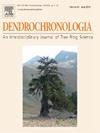Picea abies and Pinus cembra at high altitudes show different growth reaction to rising temperatures: Study from the Western Carpathian subalpine forests
IF 2.7
3区 农林科学
Q1 FORESTRY
引用次数: 0
Abstract
The subalpine forests of the Western Carpathian High Tatra Mountains represent a unique, isolated enclave of postglacial refugia. Climate change presents challenges and opportunities for alpine species: while rising temperatures may extend the growing season, potentially boosting growth rates, these changes may also push species closer to their physiological limits. This study examines the impacts of warming on the radial growth of Picea abies Karst. and Pinus cembra L. in Western Carpathian subalpine forests. We hypothesize that in subalpine zones, where tree growth is predominantly limited by low temperatures, Picea abies will experience enhanced growth under warmer conditions, whereas Pinus cembra will reduce growth under associated stress. We identified two pointer years with negative growth responses in P. cembra (1980 and 2014) and two years (1974 and 1993) with negative growth responses observed only in P. abies. The years 1965 and 1996 were found to be common years of negative response. Results indicate a non-linear relationship between temperature and radial increment. While P. abies and P. cembra both respond negatively to cold years (RWI < 1) at lower temperature sums, their responses diverge at higher temperature sums. As the cumulative sum of daily average temperatures above 9°C exceeds 1500 degree-days, spruce’s response remains positive (RWI > 1), whereas stone pine´s becomes significantly negative (RWI < 0.9). We conclude that, with continued climate manifestations, such as heatwaves, the competitive advantage of spruce in subalpine forests could potentially result in a gradual contraction of P. cembra distribution in the High Tatra Mountains.
高海拔地区云杉和松柏对气温上升的生长反应不同:来自喀尔巴阡山脉西部亚高山森林的研究
喀尔巴阡山脉西部高塔特拉山脉的亚高山森林代表了一个独特的,孤立的后冰川避难所飞地。气候变化给高山物种带来了挑战和机遇:虽然气温上升可能延长生长季节,潜在地提高生长速度,但这些变化也可能使物种更接近其生理极限。研究了增温对喀斯特云杉径向生长的影响。西部喀尔巴阡亚高山森林中的松。我们假设,在亚高山地区,树木的生长主要受到低温的限制,云杉在温暖的条件下会生长得更快,而松在相关的压力下会生长得更慢。我们确定了两个指针年(1980年和2014年)和两个指针年(1974年和1993年)只有冷杉有负生长反应。1965年和1996年被发现是负面反应的常见年份。结果表明,温度与径向增量呈非线性关系。而冷杉和青杉对寒冷年份的反应均为负(RWI <;1)在较低的温度和下,它们的响应在较高的温度和下发散。当9°C以上的日平均气温累计超过1500度时,云杉的响应仍然是积极的(RWI >;1),而石松´s变为显著负(RWI <;0.9)。我们认为,随着热浪等气候现象的持续,亚高山云杉的竞争优势可能会导致高塔特拉山脉云杉分布的逐渐缩小。
本文章由计算机程序翻译,如有差异,请以英文原文为准。
求助全文
约1分钟内获得全文
求助全文
来源期刊

Dendrochronologia
FORESTRY-GEOGRAPHY, PHYSICAL
CiteScore
5.50
自引率
13.30%
发文量
82
审稿时长
22.8 weeks
期刊介绍:
Dendrochronologia is a peer-reviewed international scholarly journal that presents high-quality research related to growth rings of woody plants, i.e., trees and shrubs, and the application of tree-ring studies.
The areas covered by the journal include, but are not limited to:
Archaeology
Botany
Climatology
Ecology
Forestry
Geology
Hydrology
Original research articles, reviews, communications, technical notes and personal notes are considered for publication.
 求助内容:
求助内容: 应助结果提醒方式:
应助结果提醒方式:


